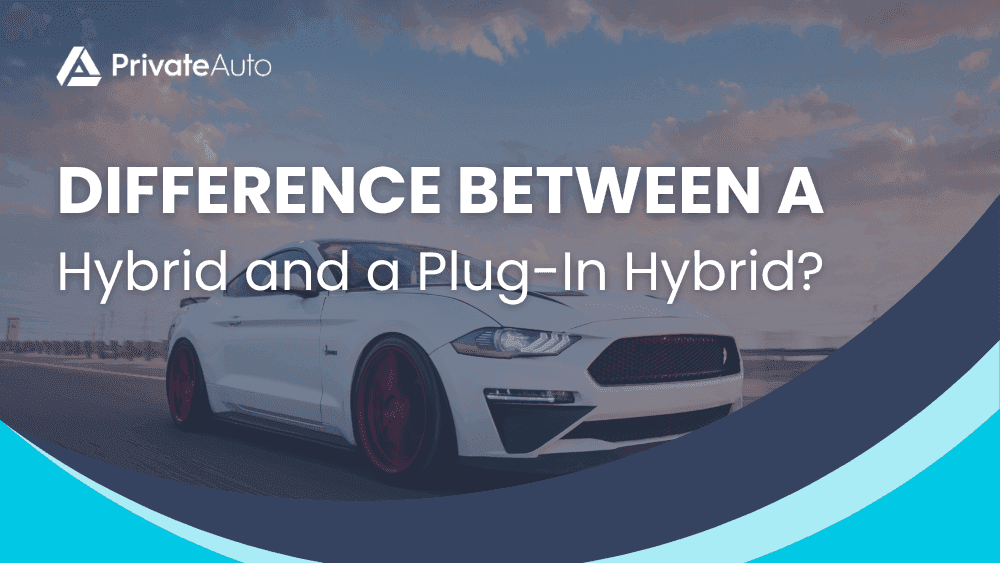What is the Difference Between a Hybrid and a Plug-In Hybrid?
Hybrid and plug-in hybrid vehicles both combine gasoline engines with electric motors, but they operate in slightly different ways. Standard hybrids are more common, while plug-in hybrids offer a more specialized electric driving experience.
We'll delve into the differences between standard hybrids and plug-in hybrids so you have all the information you need to make an informed decision between the two.
What Do Hybrids and Plug-In Hybrids Have in Common?
Hybrid and plug-in hybrid vehicles both combine a gasoline engine with an electric motor to improve fuel efficiency and reduce emissions.
Unlike conventional gasoline-only vehicles, both hybrid types use electric power to supplement or replace the gasoline engine at times. This combination of power sources results in better fuel economy than traditional internal combustion engine vehicles.
Let's look at how standard hybrids and plug-in hybrids differ.
Unlike conventional gasoline-only vehicles, both hybrid types use electric power to supplement or replace the gasoline engine at times. This combination of power sources results in better fuel economy than traditional internal combustion engine vehicles.
Let's look at how standard hybrids and plug-in hybrids differ.
What Is a Hybrid Vehicle?
A standard hybrid, usually just referred to as a “hybrid,” combines a gasoline engine with an electric motor to improve fuel efficiency. Unlike plug-in hybrids, standard hybrids can't be charged from an external power source.
Here's how a standard hybrid works:
1. The electric motor assists the gas engine during acceleration and at lower speeds, reducing fuel consumption.
2. In some models, the vehicle can run on electric power alone for short distances at low speeds.
3. The battery is recharged through regenerative braking and by the gasoline engine.
4. The gasoline engine is the primary power source, with the electric motor providing supplementary power.
Standard hybrids seamlessly switch between gas and electric power, or use both simultaneously, to optimize fuel efficiency. They're ideal for city driving where frequent stops allow for more energy regeneration. Even when the battery is low, you're still driving a more fuel-efficient vehicle than a conventional gas-only car.
Here's how a standard hybrid works:
1. The electric motor assists the gas engine during acceleration and at lower speeds, reducing fuel consumption.
2. In some models, the vehicle can run on electric power alone for short distances at low speeds.
3. The battery is recharged through regenerative braking and by the gasoline engine.
4. The gasoline engine is the primary power source, with the electric motor providing supplementary power.
Standard hybrids seamlessly switch between gas and electric power, or use both simultaneously, to optimize fuel efficiency. They're ideal for city driving where frequent stops allow for more energy regeneration. Even when the battery is low, you're still driving a more fuel-efficient vehicle than a conventional gas-only car.
What is a Plug-In Hybrid?
Plug-in hybrids, also known as PHEVs (plug-in hybrid electric vehicles), combine electric vehicle efficiency and gas-powered convenience.
You start your journey on battery power, and cruise for 20 to 60 miles, depending on the model. Once the battery runs low, the gas engine kicks in automatically, so you keep going.
There are two ways you can charge a plug-in:
1. Plug it into a regular 120-volt outlet for a slow, overnight charge.
2. Use a faster 240-volt Level 2 charger at home or public stations for a full charge in 2-4 hours.
PHEVs also use regenerative braking to recharge while driving, and can blend power from both sources when needed. Even with a drained battery, you're still driving a fuel-efficient hybrid.
Plug-in hybrid electric vehicles come in three main types:
1. Series hybrids: electric motor drives wheels, gas engine generates electricity when needed.
2. Parallel hybrids: both electric motor and gas engine can drive wheels directly.
3. Blended hybrids: use both electric and gas power simultaneously for better efficiency.
You start your journey on battery power, and cruise for 20 to 60 miles, depending on the model. Once the battery runs low, the gas engine kicks in automatically, so you keep going.
There are two ways you can charge a plug-in:
1. Plug it into a regular 120-volt outlet for a slow, overnight charge.
2. Use a faster 240-volt Level 2 charger at home or public stations for a full charge in 2-4 hours.
PHEVs also use regenerative braking to recharge while driving, and can blend power from both sources when needed. Even with a drained battery, you're still driving a fuel-efficient hybrid.
Plug-in hybrid electric vehicles come in three main types:
1. Series hybrids: electric motor drives wheels, gas engine generates electricity when needed.
2. Parallel hybrids: both electric motor and gas engine can drive wheels directly.
3. Blended hybrids: use both electric and gas power simultaneously for better efficiency.
Hybrids vs Plug-In Hybrids
Both hybrid systems combine gas engines with electric motors to improve efficiency. Plug-in hybrids offer extended electric-only range, while standard hybrids are simpler and don't require external charging.
Hybrid | Plug-in hybrid | |
Charging | Self-charging only | External charging |
Electric-only range | Limited (1-2 miles) | Extended (20-50+ miles) |
Fuel efficiency | Good | Better, especially for short trips |
Complexity | Simpler system | More complex system |
Initial cost | Generally lower | Usually higher |
Ideal use | All-purpose driving | Short commutes, city driving |
Fuel dependency | More reliant on gas | Less reliant on gas |
How Do I Know Which Hybrid is Right For Me?
Your driving habits and personal preferences will determine whether a standard hybrid or a plug-in hybrid is the better choice for you.
If you have a longer commute or frequently take extended trips, a standard hybrid gives you the flexibility of a gas-powered vehicle, but with superior fuel efficiency.
If you have a short daily commute and access to charging stations, a plug-in hybrid could be ideal. A plug-in allows you to complete most trips on electric power alone, with the gas engine available for longer journeys.
If you have a longer commute or frequently take extended trips, a standard hybrid gives you the flexibility of a gas-powered vehicle, but with superior fuel efficiency.
If you have a short daily commute and access to charging stations, a plug-in hybrid could be ideal. A plug-in allows you to complete most trips on electric power alone, with the gas engine available for longer journeys.
Popular Hybrid Vehicles
Here are the most popular plug-in hybrid models:
1. Toyota Prius Prime
2. Ford Escape Plug-in Hybrid
3. Chrysler Pacifica Hybrid
4. BMW X5 xDrive45e
5. Toyota RAV4 Prime
6. Kia Sportage Plug-in Hybrid
7. Hyundai Tucson Plug-in Hybrid
8. Jeep Wrangler 4xe
9. Volvo XC90 Recharge
10. Mitsubishi Outlander PHEV
And here are the most popular regular hybrid vehicles:
1. Toyota Prius
2. Honda Accord Hybrid
3. Honda CR-V Hybrid
4. Toyota Highlander Hybrid
5. Ford Maverick Hybrid
6. Lexus RX Hybrid
7. Toyota Corolla Hybrid
8. Hyundai Sonata Hybrid
9. Kia Niro Hybrid
10. Toyota Sienna
11. Lexus NX Hybrid
1. Toyota Prius Prime
2. Ford Escape Plug-in Hybrid
3. Chrysler Pacifica Hybrid
4. BMW X5 xDrive45e
5. Toyota RAV4 Prime
6. Kia Sportage Plug-in Hybrid
7. Hyundai Tucson Plug-in Hybrid
8. Jeep Wrangler 4xe
9. Volvo XC90 Recharge
10. Mitsubishi Outlander PHEV
And here are the most popular regular hybrid vehicles:
1. Toyota Prius
2. Honda Accord Hybrid
3. Honda CR-V Hybrid
4. Toyota Highlander Hybrid
5. Ford Maverick Hybrid
6. Lexus RX Hybrid
7. Toyota Corolla Hybrid
8. Hyundai Sonata Hybrid
9. Kia Niro Hybrid
10. Toyota Sienna
11. Lexus NX Hybrid
Buy Your Next Car on PrivateAuto
If you're buying a private-party vehicle, whether hybrid or not, you'll love the security, speed, and convenience of PrivateAuto, the world's only transactional marketplace for private-party car deals.
1. We're the number one website to find cars for sale by owner. We have 100% private-party cars for sale, so you won’t be wading through dealership listings.
2. Browse listings with clean history reports, service records, and all relevant documentation.
3. We use technological solutions for every stage of the deal. You get security, speed, and convenience without paying fees.
4. Pay for your car instantly with no fees. PrivateAuto Pay has Venmo-like immediacy and convenience—without Venmo’s transaction limits. It’s the only way to instantly, safely, and conveniently transfer more than $5,000 in the USA.
You can filter PrivateAuto’s cars for sale in your area to see what sellers are asking for. Then, with our innovative offer feature, you can make an offer that works for your budget, sit back, and see if it gets accepted!
1. We're the number one website to find cars for sale by owner. We have 100% private-party cars for sale, so you won’t be wading through dealership listings.
2. Browse listings with clean history reports, service records, and all relevant documentation.
3. We use technological solutions for every stage of the deal. You get security, speed, and convenience without paying fees.
4. Pay for your car instantly with no fees. PrivateAuto Pay has Venmo-like immediacy and convenience—without Venmo’s transaction limits. It’s the only way to instantly, safely, and conveniently transfer more than $5,000 in the USA.
You can filter PrivateAuto’s cars for sale in your area to see what sellers are asking for. Then, with our innovative offer feature, you can make an offer that works for your budget, sit back, and see if it gets accepted!
Hybrid FAQ
What happens if you never plug in a plug-in hybrid?
Neglecting to charge your plug-in hybrid regularly will take a toll on its battery. Think of it like a muscle—it needs exercise to stay healthy. If you consistently leave the battery at low charge, it will lose some of its capacity over time.
To keep your battery in top shape and get the most out of your plug-in hybrid, plug it in regularly, even if you haven't used up all the charge.
To keep your battery in top shape and get the most out of your plug-in hybrid, plug it in regularly, even if you haven't used up all the charge.
Is a plug-in hybrid better than hybrid?
Why is a plug-in hybrid so expensive?
Why are hybrids better than EVs?
Why are plug-in hybrids not popular?
Do plug-ins have larger batteries than regular hybrids?
Further Reading

Landon Epperly
Contributing Author
Landon Epperly is the Product Manager at PrivateAuto, where he thrives on turning innovative ideas into reality. With a deep passion for cars and boats, Landon combines his love for vehicles with his expertise in product development to enhance the online marketplace experience....


